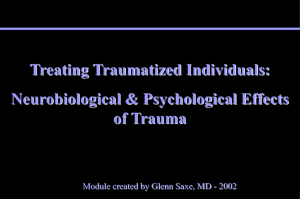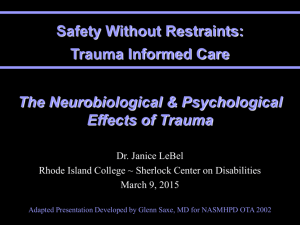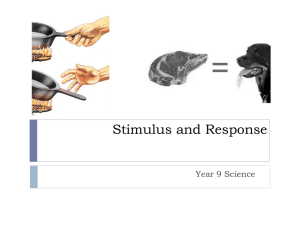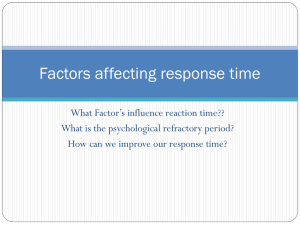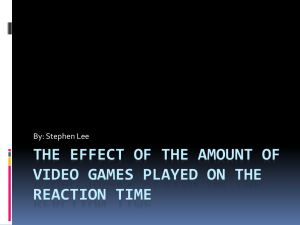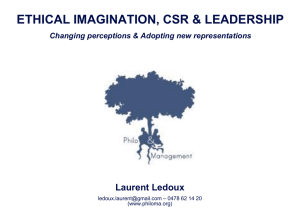Biopsychosocial Impact of Trauma
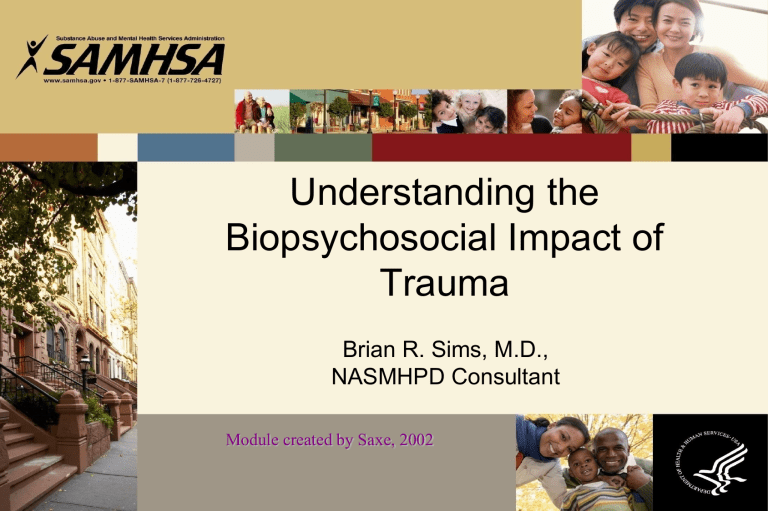
Understanding the
Biopsychosocial Impact of
Trauma
Brian R. Sims, M.D.,
NASMHPD Consultant
Module created by Saxe, 2002
Longitudinal Course of PTSD Symptoms in Children with Burns
50
45
40
35
30
25
20
15
10
5
0
Acute Assessment 3 Month Assessment
Time Period
Lateral Ventricles Measures in an 11 Year Old
Maltreated Male with Chronic PTSD, Compared with a
Healthy, Non-Maltreated Matched Control
(De Bellis et al., 1999)
From Neurons to Neighborhoods:
The Science of Early Child Development
Report from the Institute of Medicine/National
Academies National Research Council
Trauma in American Children
• 3 million children were suspected of being victims of abuse and/or neglect in 1998 (
Mazelis, 1999
)
• 3.9 million adolescents have been victims of serious physical assault, and almost 9 million have witnessed an act of serious violence (
Kilpatrick et al., 2001
)
• In 1998, 92% of incarcerated girls reported sexual, physical or severe emotional abuse in childhood
( Acoca & Dedel,, 1998 )
• Each year between 3.5 and 10 million children witness the abuse of their mother – up to half are victims of abuse themselves
( Edelson, 1999 )
PTSD Rates
• 8-14% of PTSD rates in the general population and among certain disadvantaged groups may even be higher.
(Kaplan et al., 1994; Kessler et al., 1995)
• Trauma victimizations studies show prevalence between 51-98% among persons with serious mental illness (SMI) in the public sector.
(Goodman et al., 1997; Muesar et al.,
1998))
Effective Treatment Must Account For:
1) A dysregulated nervous system
2) A social-environment that cannot contain this dysregulation
Core Concepts of Development
1) The development of children unfolds along individual pathways whose trajectories are characterized by continuities and discontinuities, as well as by a series of significant transitions.
( Shonkoff & Phillips, 2000 )
309.81 PTSD Definition
• The development of characteristic symptoms, following exposure to a traumatic stressor involving direct personal experience or witnessing another persons’ experience of:
– Actual or threatened death
– Actual or threatened serious injury
– Threat to physical integrity
Post Traumatic Stress Disorder
• Characterized by:
– Re-experiencing the event
• Intrusive thoughts, nightmares, or flashbacks that recollect traumatic images and memories
– Avoidance and emotional numbing
• Flattening of affect, detachment from others, loss of interest, lack of motivation, and constant avoidance of any activity, place, person, or event associated with the traumatic experience
Core Concepts of Development
2) The growth of self regulation is a cornerstone of early development that cuts across all behavioral domains.
( Shonkoff & Phillips, 2000 )
State Change
22 year-old man with history of childhood physical abuse displayed aggressive behavior on psychiatric unit and was physically restrained.
Calm/
Continuous/
Engaged
Aggression
Dissociation
Fear
State Change
12 year-old sexually abused girl in school when provoked by older male peer.
Shame
Fear
Calm/
Continuous/
Engaged
Dissociation
Self Mutilation
Parameters that change between state
•Affect
•Thought
•Behavior
•Sense-of-self
•Consciousness
Emotional States and Child Development
• Discrete behavioral states are a central organizing experience of infancy
• Infants experiential world is divided into separate and definable emotional/behavioral states
• Critical task of early child development is to build smooth transitions/bridges between states
• Regulation of emotion is initially contingent on caregivers facilitating these transitions.
( Wolff , 1987 )
Goal of Treatment
• Maintain Calm/Continuous/
Engaged State
• Prevent Discontinuous States
• Build Cognitive Structures that allow choices
Between Stimulus and Response
Stimulus
Response
Between Stimulus and Response
Stimulus
Traumatic Reminder
Trigger
Socialenvironmental intervention
Response
Neuroregulatory
Intervention
Intervention
Between Stimulus and Response
Stimulus
Traumatic Reminder
Trigger
COGNITION!!!
Response
Socialenvironmental
Intervention
Neuroregulatory
Intervention
Intervention
Core Concepts of Development
3) Human development is shaped by a dynamic and continuous interplay between biology and experience.
( Shonkoff & Phillips, 2000 )
Emotional Brain
( Restak, 1988 )
Between Stimulus and Response
Stimulus
( LeDoux, 1996 )
Between Stimulus and Response
S Stimulus
Sensory Thalamus
(LeDoux, 1996)
Between Stimulus and Response
Stimulus
Sensory Thalamus
Very Fast
Amygdala
( LeDoux, 1996 )
Between Stimulus and Response
Cortex
Hippocampus Slower
Amygdala
Stimulus
Sensory Thalamus Very Fast
( LeDoux, 1996 )
Between Stimulus and Response
Cortex
Hippocampus Slower
Amygdala
Stimulus
Sensory Thalamus Very Fast
Response
( LeDoux, 1996 )
Between Stimulus and Response
Cortex
Hippocampus Slower
Amygdala
Stimulus
Sensory Thalamus Very Fast
Response
( LeDoux, 1996 )
Between Stimulus and Response
Cortex
Hippocampus Slower
Amygdala
Stimulus
Sensory Thalamus Very Fast
Response
( LeDoux, 1996 )
Between Stimulus and Response
Cortex
Hippocampus Slower
Amygdala
Stimulus
Sensory Thalamus Very Fast
Response
( LeDoux, 1996 )
Between Stimulus and Response
Cortex
Hippocampus
Slower
Amygdala
Stimulus
Sensory Thalamus Very Fast
Response
( LeDoux, 1996 )
Between Stimulus and Response
Social
Environmental
Intervention
Cortex
Psychotherapy
Neuroregulatory
Intervention
Hippocampus
Slower
Amygdala
Stimulus
Sensory Thalamus Very Fast
Psychopharmacology
Response
( LeDoux, 1996 )
Rauch Brain scans
Play
( Panksepp, 1998 )
Play and Fear
( Panksepp, 1998 )
Core Concepts of Development
4) Human relationships, and the effects of relationships on relationships, are the building blocks of healthy development.
( Shonkoff & Phillips, 2000 )
Attachment
• Earliest relationships critical for capacity to regulate state
• Neglectful and traumatic early relationships set up person to respond with state dysregulation to interpersonal cues in subsequent relationships.
Attachment & Relational Deficits
• Appear guarded & anxious
• Difficult to re-direct, reject support
• Highly emotionally reactive
• Hold on to grievances
• Do not take responsibility for behavior
• Make the same mistakes over and over
•
• Repetition compulsion / traumatic reenactment
(Hodas, 2004)
Traumatic Relationships
• Emotions expressed in interpersonal relationships can be extremely painful and can be related to trauma experience
• These trauma-based emotions (e.g. anger, fear, hopelessness, sexual arousal) can be very hard for clinicians to tolerate
• Clinicians must be mindful about their experience of trauma-based emotion so that this emotion is not enacted in the clinical relationship.
Core Concepts of Development
5) Children are active participants in their own development, reflecting the intrinsic human drive to explore and master one’s environment.
( Shonkoff & Phillips, 2000 )
Traumatic Mastery
•Many children have primarily experienced abusive and neglectful relationships
• Extreme behaviors within relationships can be seen as defensive or selfprotective
• Traumatized children respond to their trauma history in the present. They are not able to discern that the context has changed
• This behavior must be seen as an attempt to master extremely difficult environments
• In this way, traumatized children are
“doing the best that they can”
Core Concepts of Development
6) The course of development can be altered…by effective interventions that change the balance between risk and protection, thereby shifting the odds in favor of more adaptive outcomes.
(Shonkoff & Phillips, 2000)
TAKE HOME IDEAS
• Set up calm and nurturing environments
• Teach staff to meticulously observe for ‘triggers’ – when someone is beginning to move from a calm, continuous state to a discreet state of emergency
• Train to caring and compassion
• Meticulously interview for triggers
• Adjust the environment
• Adjust what we do (i.e., look at ourselves and our behaviors and actions as the key for success)
CONCLUSIONS
• Response to traumatic stress is learned behavior, mediated by the brain & the social environment
• Traumatic stress brings the past to the present
• The survival response impacts the mind, body, behavior & speech “… the amygdala leads a hostile takeover of consciousness by emotion.”
(LeDoux,
2002 )
• To change the response, create new learning & skills:
– Analyze & adapt
– Buffer & bolster
– Teach, support, & build that “cognitive wedge”
